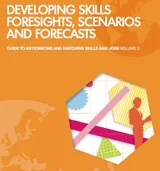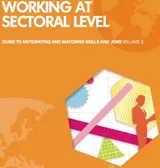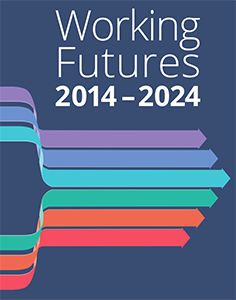IER News & blogs
Working Futures 2014-2024
Working Futures 2014-2024 is the sixth in a series of quantitative assessments of employment prospects in the UK labour market over a 10 year horizon, created for the UK Commission for Employment and Skills by Cambridge Econometrics and the Warwick Institute for Employment Research. The projections were prepared in late 2015 and early 2016 and are based on a view of the likely medium-term evolution of the economy at that time. With the support of UKCES and the Department for Education, the Warwick IER created a web page from which all the reports and outputs from these projections can be downloaded. The main output of the projection exercise is a set of Excel workbooks containing historical trends and future prospects for output and employment by industry sector for the UK and its constituent nations and the English regions. Workbooks for smaller geographical areas are also being made available (to authorised users only).
Guides to anticipating and matching skills
Two guides, authored by IER’s Professor Rob Wilson, which are part of the ETF, ILO and Cedefop series of guides on skills anticipation and matching have been published.
 Volume 2 covers the development of skills foresights, scenarios and skills forecasts, and aims to support setting up skills forecasting systems at national level by means of quantitative and/or qualitative approaches. The guide is intended specifically for countries which are starting to develop systems of skill needs anticipation.
Volume 2 covers the development of skills foresights, scenarios and skills forecasts, and aims to support setting up skills forecasting systems at national level by means of quantitative and/or qualitative approaches. The guide is intended specifically for countries which are starting to develop systems of skill needs anticipation.
Bakule, M., Czesaná, V., and Havlícková, V. (Part A), Kriechel, B., Rašovec, B. and Wilson, R. (Part B) (2016) Developing Skills Foresights, Scenarios and Forecasts - Guide to Anticipating and Matching Skills and Jobs (Vol. 2). Luxembourg: Publications Office of the European Union, (ISBN: 978-92-9157-655-5)
 Volume 3 examines sectors as the key points where changes in skills demand occurs, the term sector being used to define specific areas of economic activity. It provides an overview of the role of sectoral bodies and what they do in anticipating changing skills needs. The country case studies show how skills are analysed at the sector level in different contexts and conditions.
Volume 3 examines sectors as the key points where changes in skills demand occurs, the term sector being used to define specific areas of economic activity. It provides an overview of the role of sectoral bodies and what they do in anticipating changing skills needs. The country case studies show how skills are analysed at the sector level in different contexts and conditions.
Wilson, R., Tarjáni, H. and Rihova, H. (2016) Working at Sectoral Level - Guide to Anticipating and Matching Skills and Jobs (Vol. 3). Luxembourg: Publications Office of the European Union, (ISBN: 978-92-9157-657-9)
Upheaval and opportunity in the future labour market
Professor Rob Wilson contributes to NatWest's recent blog 'The 50% with Prospects?'. Drawing on IER's Working Futures work, produced by Rob with colleagues in IER and Cambridge Econometrics, he explains that, despite policies to reduce gender discrimination, the occupational employment structure remains “strongly segregated". Rob also talks about the losses of secretarial positions are expected to continue, but an uptick in the female-heavy caring and leisure sectors could provide a counterbalance. Find out more about the future labour market in Working Futures 2014-2014.
work, produced by Rob with colleagues in IER and Cambridge Econometrics, he explains that, despite policies to reduce gender discrimination, the occupational employment structure remains “strongly segregated". Rob also talks about the losses of secretarial positions are expected to continue, but an uptick in the female-heavy caring and leisure sectors could provide a counterbalance. Find out more about the future labour market in Working Futures 2014-2014.
Cedefop Publishes Forecasting Reports
Today sees the publication of two reports by Cedefop, the European Centre for the Development of Vocational Training. These reports are the latest in a series of publications from a 4-year skills demand and supply forecasting project led by IER’s Rob Wilson, working in collaboration with Cedefop and a consortium of partners across Europe.
The latest skill demand and supply forecasts produced for Cedefop aim to provide evidence on future labour market developments to help to make informed decisions. The main findings of the latest skill demand and supply forecast for the European Union for 2010-20 indicate that although the economic conditions will determine only a modest increase in job openings, current trends, including a shift to more skill-intensive jobs, a demand for people to be better qualified and more jobs in services, will continue.
produced for Cedefop aim to provide evidence on future labour market developments to help to make informed decisions. The main findings of the latest skill demand and supply forecast for the European Union for 2010-20 indicate that although the economic conditions will determine only a modest increase in job openings, current trends, including a shift to more skill-intensive jobs, a demand for people to be better qualified and more jobs in services, will continue.
The second publication provides an overview of the methodological framework used to underpin the skills forecasting project.
provides an overview of the methodological framework used to underpin the skills forecasting project.
IER Publishes its 100th Bulletin
IER has pioneered labour market assessment and forecasting work in the UK, and remains at the forefront of employment forecasting with an international reputation for the quality of its work.
The 100th IER Bulletin summarises the findings of Working Futures 2010-2020, the fourth in a series of labour market assessments that provide detailed projections for the UK labour market. It focuses on a ten year horizon, giving a picture of the labour market for 2020; including employment prospects for industries, occupations, qualification levels, gender and employment status for the UK and for nations and English regions. The core purpose of Working Futures is to inform policy development and strategy around skills, careers and employment.
The wordle below illustrates the key words used in the Bulletin.

For further information on IER Forecasting, contact Rob Wilson (r.a.wilson@warwick.ac.uk; 02476 523530)

